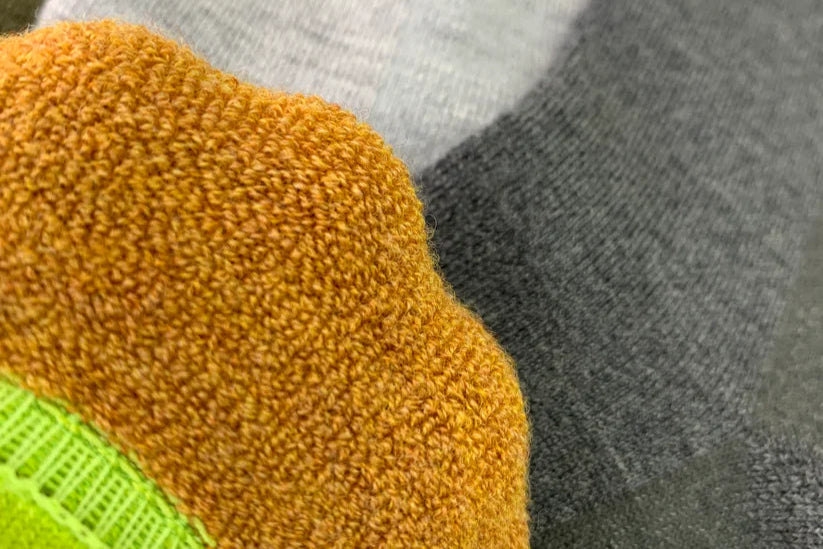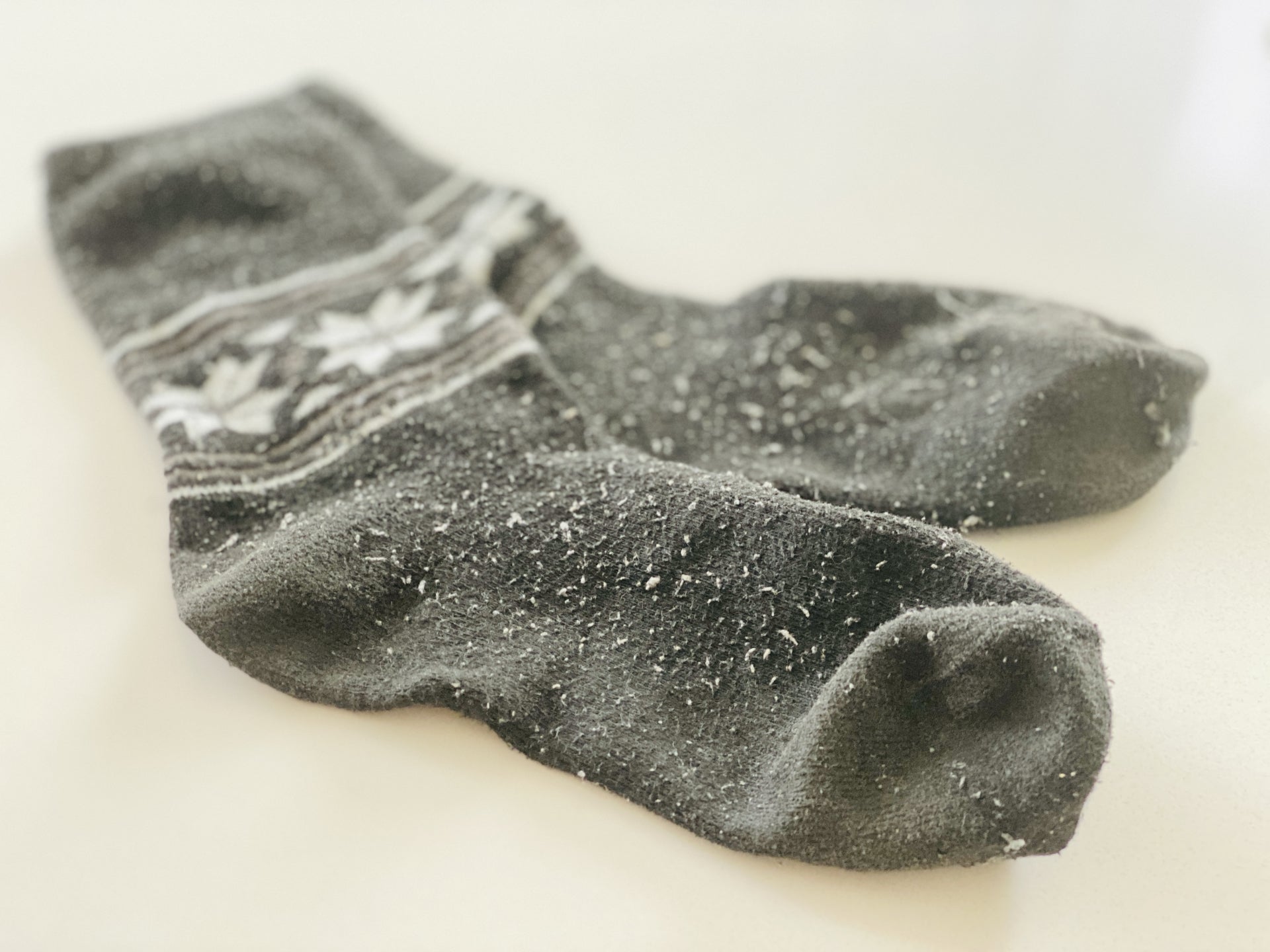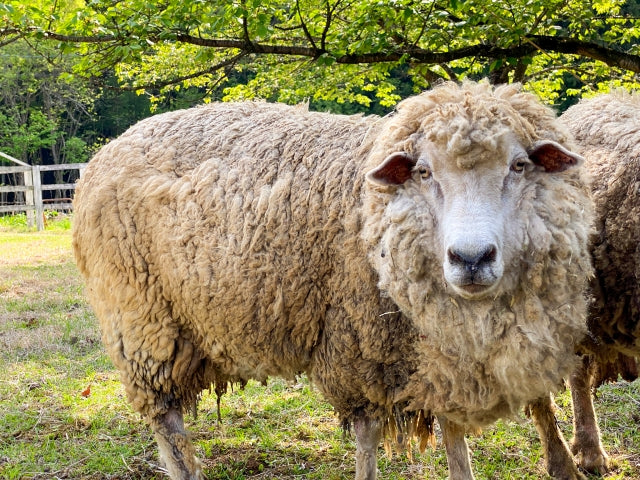Hello. I'm Hiroki, a new staff member at OLENO.
I've been studying wool for two months now, and I've gotten to know it quite well, and I've started to pay more attention to the materials used in the clothes I wear.
Meanwhile, when I was sorting out my dresser for winter, I came across some wool socks with holes in them...

I thought about throwing them away, but then the thought crossed my mind: is there no other way to throw away socks with holes in them? So I did some research on holes in wool socks = moth damage. For those who are also troubled by the moth damage problem in wool or merino wool socks, I would like to summarize some measures that anyone can take to prevent moth damage and what to do when holes appear in socks .
(I'm talking about wool socks, but the basics are the same for knitted sweaters and scarves that also use wool, except for the repair methods.)
5 ways to prevent moth damage to wool socks
1. Keep it clean

Not only wool socks, but any wool product is a target for insects if it has sebum and dirt on it, which are sources of nutrition for insects. Be sure to thoroughly remove any dirt before storing them in a dresser or closet.
Also, pests like humidity and are insidious, so it is best to store them in a place where humidity is unlikely to accumulate (a sunny south-facing room, a room that is not dried indoors, a place where condensation is unlikely to occur such as behind a window or furniture, etc.).
2. Use insect repellent

Closets and cupboards are known to be places where moisture easily accumulates, and if no measures are taken, they will be eaten by insects. Therefore, when storing wool socks in a closet or storage case, it is effective to put an insect repellent in the same place .
When storing woolen products such as wool socks, it is safe to choose an moth repellent specifically for woolen products and place paper or cloth between the socks and the products to prevent direct contact.
Here is an article that lists some recommended moth repellents for wool.
Recommended insect repellents: Popular rankings [2024]
3. Store properly

We don't recommend storing it in a safe, but since wool is a material that is sensitive to moisture and heat, it's best to store it in a well-ventilated place .
Also, if you are storing it for a long time, it is safer to use a sealable storage bag or box and put a desiccant in it. In short, I think it would be good to put a desiccant and an insect repellent in the storage box .
4. Try natural insect repellents

We talked about insect repellents earlier, but if you use insect repellents, your system will be even more solid. Insect repellents are used to prevent the occurrence of pests , while insect repellents have a different effect and do not prevent pests from entering the home .
The original use of insect repellents is to prevent blood-sucking pests such as mosquitoes and ticks from sucking your blood by reducing their ability to recognize you, but using natural insect repellent materials such as lavender, cedarwood, and mint also makes it harder for pests to approach.
I wouldn't say you should put one in a storage box, but it might be nice to have one in your closet.
5. Expose it to air regularly

We have mentioned four methods so far, but removing dirt, using insect repellent, storing it properly, and placing insect repellent are not all perfect ways to prevent moth damage to wool.
Since it is impossible to wipe away all moisture, insects will breed if left for a long time. Therefore, you can prevent insects from breeding by lightly exposing it to sunlight outside on a sunny day or drying it in the shade in a well-ventilated place (be careful not to expose it to sunlight).
If you already have a hole in it, you can either repair it or buy a new one.
Some of you may already have holes and are gathering information on what to do, so we will also summarize the measures (repair methods) that can be taken after holes have appeared due to insect damage.
Traditional repair method "darning"
Nowadays, there are tools available that make it easy to repair things, such as repair stickers and iron-on patches, but because they inevitably have a negative effect on the flexibility of wool socks, a method called darning is still recommended.

The above numbers have no meaning
Tools needed
Wool socks (with holes)
Darning mushroom (if you don't have one, you can use the bottom of a glass or a small bowl)
Yarn or embroidery thread (similar to the color of your socks or an accent color)
A needle (a blunt-tipped darning or embroidery needle works best)
Scissors Wide-toothed comb (if desired)
Repair Procedure
Step 1: Prepare the sock <br>Lay the sock on a flat table so you can see the hole clearly.
Place the darning mushroom under the hole, holding the fabric taut (you can also use a rubber band to hold it in place).
Step 2: Prepare your thread and needle <br>Thread your needle with wool or embroidery thread. A length of thread of about 30-40cm is easy to work with.
Tie a knot at the end of the thread.
Step 3: Secure the edges of the hole . Sew all around the hole, pulling the thread tight to prevent it from fraying. The stitch should be small and go all the way around the edge of the hole.
Step 4: Make the warp threads <br>Pass a needle through the top and bottom holes to create several warp threads. Repeat, pulling the threads taut.
Step 5: Weaving the weft <br>Thread the weft between the warp threads. Move the needle up and down, weaving alternately over and under the warp threads. Cut the thread when you're done and secure it with a knot.
Step 6: Finish <br>Remove the needle and thread and gently tug the repair to smooth it out.
If necessary, lightly iron to reshape for a prettier look.
Supplementary points
If you don't have the tools: You can use a small bowl or a round stone instead of a darning mushroom.
Add a design element: Using colorful repair thread to create a patch-like finish will give your item an original look.
Practice: It's a good idea to test the technique on an old piece of fabric before repairing a real sock.
Just in case,
I've attached a page with pictures explaining how to darn.
Above, we have summarized how to prevent wool socks from being eaten by moths and how to repair them if they have been eaten by moths.
For someone as clumsy as me, repairs are difficult, so I thought it would be better to take proper measures to prevent insects from eating it, and then buy a new one if it gets eaten by insects (lol).
By the way, the CEO of our company OLENO is a huge wool lover and has developed a variety of wool socks and neck warmers, so please check them out! I think he would be very happy (laughs).
[OLENO Merino wool product list]
- A record-breaking crowdfunded merino wool neck sleeve
・These premium wool socks are made from the highest quality wool.
・Wool in summer?! Wool and mesh socks made with thorough research

Wool socks are the most comfortable and warmest to wear, and I will be trying out the moth prevention tips introduced here to help them last longer.
Thank you for reading to the end.
[Articles about wool]
・[Use them according to the situation] The difference between lamb's wool and merino wool
・Disparities exist within merino wool
Merino wool is a high-quality wool. We looked into its pros and cons.
・[Benefits] Wool? Polyester? Learn the differences between socks based on material





